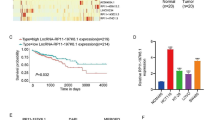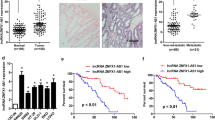Abstract
Long non-coding RNAs (lncRNAs) and microRNAs (miRNAs) are essential regulators in human cancers, while the role of lncRNA X-inactive-specific transcript (XIST) in colorectal cancer (CRC) via regulating miR-448 remains largely unknown. Herein, we aimed to elucidate the effect of the XIST/miR-448/grainyhead-like 2 (GRHL2) axis on CRC development. XIST, miR-448, and GRHL2 expression in CRC tissues from patients and in human CRC cell lines was assessed. Loss- and gain-function assays were implemented to unveil the roles of XIST, miR-448, and GRHL2 in screened CRC cells. The tumor growth in vivo was observed in nude mice. Binding relations among XIST, miR-448, and GRHL2 were evaluated. XIST and GRHL2 expressed highly whereas miR-448 expressed lowly in CRC tissues and cells. XIST or GRHL2 downregulation, or miR-448 elevation suppressed the malignant behaviors of CRC cells in vitro, and downregulated XIST or upregulated miR-448 also inhibited the tumor growth in vivo. miR-448 upregulation reversed the role of XIST elevation in CRC cells. XIST particularly bound to miR-448, and miR-448 targeted GRHL2. Knockdown of XIST upregulates miR-448 to impede malignant behaviors of CRC cells via inhibiting GRHL2. This study may provide novel biomarkers for CRC diagnosis and treatment.








Similar content being viewed by others
References
Afrasanie VA et al (2019) KRAS, NRAS, BRAF, HER2 and microsatellite instability in metastatic colorectal cancer - practical implications for the clinician. Radiol Oncol 53(3):265–274
Aran V et al (2016) Colorectal cancer: epidemiology, disease mechanisms and interventions to reduce onset and mortality. Clin Colorectal Cancer 15(3):195–203
Bamodu OA et al (2016) Aberrant KDM5B expression promotes aggressive breast cancer through MALAT1 overexpression and downregulation of hsa-miR-448. BMC Cancer 16:160
Cheng R et al (2018) B7–H3 expression and its correlation with clinicopathologic features, angiogenesis, and prognosis in intrahepatic cholangiocarcinoma. APMIS 126(5):396–402
Chen DL et al (2017) Long noncoding RNA XIST expedites metastasis and modulates epithelial-mesenchymal transition in colorectal cancer. Cell Death Dis 8(8):e3011
Deng J et al (2018) Long non-coding RNA OIP5-AS1 functions as an oncogene in lung adenocarcinoma through targeting miR-448/Bcl-2. Biomed Pharmacother 98:102–110
Deng Z et al (2020) Prognostic and predictive role of DNA mismatch repair status in stage II-III colorectal cancer: a systematic review and meta-analysis. Clin Genet 97(1):25–38
Dong Y et al (2020) Long non-coding RNA XIST regulates hyperglycemia-associated apoptosis and migration in human retinal pigment epithelial cells. Biomed Pharmacother 125:109959
Ferlay J et al (2015) Cancer incidence and mortality worldwide: sources, methods and major patterns in GLOBOCAN 2012. Int J Cancer 136(5):E359–E386
Guo JC et al (2019) microRNA-448 inhibits stemness maintenance and self-renewal of hepatocellular carcinoma stem cells through the MAGEA6-mediated AMPK signaling pathway. J Cell Physiol 234(12):23461–23474
Hong W et al (2020) lncRNA LINC00460 silencing represses EMT in colon cancer through downregulation of ANXA2 via upregulating miR-433–3. Mol Ther Nucleic Acids 19:1209–1218
Hong Y, Rao Y (2019) Current status of nanoscale drug delivery systems for colorectal cancer liver metastasis. Biomed Pharmacother 114:108764
Hu F et al (2019) Knockdown of GRHL2 inhibited proliferation and induced apoptosis of colorectal cancer by suppressing the PI3K/Akt pathway. Gene 700:96–104
Kamarudin MNA et al (2019) Metformin in colorectal cancer: molecular mechanism, preclinical and clinical aspects. J Exp Clin Cancer Res 38(1):491
Li B et al (2016) miR-448 suppresses proliferation and invasion by regulating IGF1R in colorectal cancer cells. Am J Transl Res 8(7):3013–3022
Liu A, Liu L, Lu H (2019) LncRNA XIST facilitates proliferation and epithelial-mesenchymal transition of colorectal cancer cells through targeting miR-486-5p and promoting neuropilin-2. J Cell Physiol 234(8):13747–13761
Liu H et al (2018) LncRNA XIST/miR-34a axis modulates the cell proliferation and tumor growth of thyroid cancer through MET-PI3K-AKT signaling. J Exp Clin Cancer Res 37(1):279
Liu ML et al (2018) Long noncoding RNA RP4 functions as a competing endogenous RNA through miR-7-5p sponge activity in colorectal cancer. World J Gastroenterol 24(9):1004–1012
Lou Q et al (2019) miR-448 targets IDO1 and regulates CD8(+) T cell response in human colon cancer. J Immunother Cancer 7(1):210
Ma L et al (2017) Long non-coding RNA XIST promotes cell growth and invasion through regulating miR-497/MACC1 axis in gastric cancer. Oncotarget 8(3):4125–4135
Quan Y et al (2014) Downregulation of GRHL2 inhibits the proliferation of colorectal cancer cells by targeting ZEB1. Cancer Biol Ther 15(7):878–887
Riquelme I et al (2016) miR-101-2, miR-125b-2 and miR-451a act as potential tumor suppressors in gastric cancer through regulation of the PI3K/AKT/mTOR pathway. Cell Oncol (dordr) 39(1):23–33
Shang AQ et al (2019) Knockdown of long noncoding RNA PVT1 suppresses cell proliferation and invasion of colorectal cancer via upregulation of microRNA-214–3. Am J Physiol Gastrointest Liver Physiol 317(2):222–232
Shao C et al (2017) Expression and significance of GRHL2 in esophageal cancer. Onco Targets Ther 10:2025–2031
Shi J et al (2020) LncRNA XIST knockdown suppresses the malignancy of human nasopharyngeal carcinoma through XIST/miRNA-148a-3p/ADAM17 pathway in vitro and in vivo. Biomed Pharmacother 121:109620
Su HY et al (2018) MiR-448 downregulates CTTN to inhibit cell proliferation and promote apoptosis in glioma. Eur Rev Med Pharmacol Sci 22(12):3847–3854
Wang G et al (2019) Novel long noncoding RNA OTUD6B-AS1 indicates poor prognosis and inhibits clear cell renal cell carcinoma proliferation via the Wnt/beta-catenin signaling pathway. Mol Cancer 18(1):15
Wei W et al (2017) LncRNA XIST promotes pancreatic cancer proliferation through miR-133a/EGFR. J Cell Biochem 118(10):3349–3358
Wu X et al (2016) miR-448 suppressed gastric cancer proliferation and invasion by regulating ADAM10. Tumour Biol 37(8):10545–10551
Yue M et al (2018) Paeoniflorin inhibits cell growth and induces cell cycle arrest through inhibition of FoxM1 in colorectal cancer cells. Cell Cycle 17(2):240–249
Zhang B et al (2007) microRNAs as oncogenes and tumor suppressors. Dev Biol 302(1):1–12
Zhang XT et al (2019) Long non-coding RNA (lncRNA) X-inactive specific transcript (XIST) plays a critical role in predicting clinical prognosis and progression of colorectal cancer. Med Sci Monit 25:6429–6435
Zhou Q et al (2018) Long non coding RNA XIST as a prognostic cancer marker - a meta-analysis. Clin Chim Acta 482:1–7
Zhu H et al (2018) LncRNA XIST accelerates cervical cancer progression via upregulating Fus through competitively binding with miR-200a. Biomed Pharmacother 105:789–797
Zhu J et al (2018) Knockdown of long non-coding RNA XIST inhibited doxorubicin resistance in colorectal cancer by upregulation of miR-124 and downregulation of SGK1. Cell Physiol Biochem 51(1):113–128
Zhu XQ et al (2020) Qingjie Fuzheng granules regulates cancer cell proliferation, apoptosis and tumor angiogenesis in colorectal cancer xenograft mice via Sonic Hedgehog pathway. J Gastrointest Oncol 11(6):1123–1134
Funding
This study was funded by Shanxi Province “136 Revitalization Medical Project Construction Funds”.
Author information
Authors and Affiliations
Corresponding author
Ethics declarations
Conflict of interest
The authors declare no competing interests.
Additional information
Publisher's note
Springer Nature remains neutral with regard to jurisdictional claims in published maps and institutional affiliations.
Supplementary Information
Below is the link to the electronic supplementary material.
Rights and permissions
About this article
Cite this article
Yan, Z., Li, J., Guo, J. et al. LncRNA XIST sponges microRNA-448 to promote malignant behaviors of colorectal cancer cells via regulating GRHL2. Funct Integr Genomics 22, 977–988 (2022). https://doi.org/10.1007/s10142-022-00873-5
Received:
Revised:
Accepted:
Published:
Issue Date:
DOI: https://doi.org/10.1007/s10142-022-00873-5




